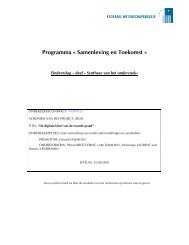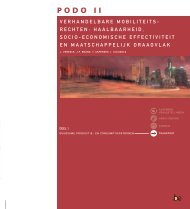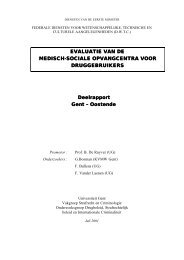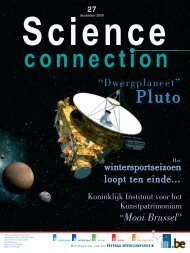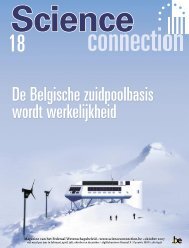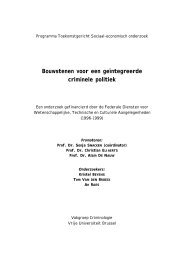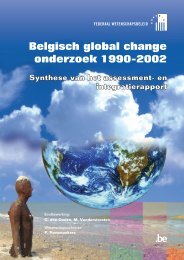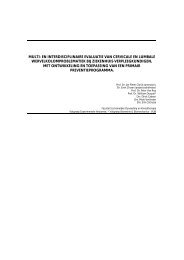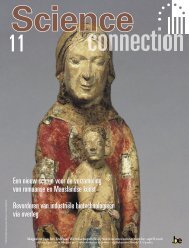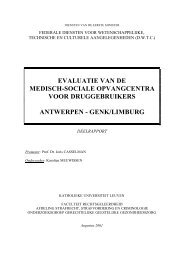chapter 3 inventory of local food systems
chapter 3 inventory of local food systems
chapter 3 inventory of local food systems
You also want an ePaper? Increase the reach of your titles
YUMPU automatically turns print PDFs into web optimized ePapers that Google loves.
Project CP/59 - “Instruments and institutions to develop <strong>local</strong> <strong>food</strong> <strong>systems</strong>”<br />
production costs? How should the cost <strong>of</strong> a product be calculated? This problem is<br />
concretised in the weekly composition <strong>of</strong> the vegetable boxes, as consumers are still<br />
free to choose the producer they will buy from.<br />
The second dilemma is the tension between the individual visions <strong>of</strong> the farmers and the<br />
shared vision <strong>of</strong> the cooperative. The cooperative’s success depends on the degree to<br />
which these coincide. Similar tensions have led to a break out from the original group <strong>of</strong><br />
farmers. But also in the current, smaller group there is no full understanding <strong>of</strong> each<br />
other’s vision. This leads to underinvestment in the collective <strong>of</strong> both time and money,<br />
and a stagnation <strong>of</strong> the initiative. Hence, the degree to which the vision is shared will<br />
also determine the depth <strong>of</strong> the collaboration.<br />
The third dilemma is the contradiction between fast and slow. Of course this is related<br />
to the previous dilemma, as a shared vision will speed up the action. Taking time in the<br />
beginning to build trust is necessary for building effective teams and a shared vision.<br />
However, when in meetings the social aspects tend to dominate, decisions are<br />
postponed leading to inaction.<br />
4.3.2. Case B: Meat marketing cooperative<br />
Case B is a cooperative <strong>of</strong> five farmers selling meat through box schemes and an internet<br />
shop. Individually, some <strong>of</strong> the farmers also use various other marketing channels. Five<br />
breeders (pigs, cattle, poultry, rabbits and sheep) using alternative methods to produce<br />
high quality meat established the cooperative in 2002 to market their niche products.<br />
The breeders were supported by an NGO that coordinated a box scheme. The<br />
cooperative collects orders, buys animals from the cooperative members, has them<br />
slaughtered, has the meat processed by a hired boucher and sells the meat directly to<br />
the consumer. The cooperative members contribute in the packaging <strong>of</strong> the meat and<br />
transportation <strong>of</strong> the animals and the meat. In 2004 the NGO and the cooperative<br />
jointly created a label and a webshop in the framework <strong>of</strong> the a government funded<br />
project. We distinguished four sets <strong>of</strong> dillemas for this cooperative.<br />
The first dilemma is the tension between pioneers and followers. This dilemma is similar<br />
but not quite the same as the dilemma fast-slow in case A. To capture scale economies<br />
the cooperative needs to grow and take further steps. Different risk pr<strong>of</strong>iles <strong>of</strong> the<br />
members leads to different opinions with respect to development <strong>of</strong> the cooperative.<br />
But, the fact that pioneers invest more resources (money and time) in the cooperative<br />
without necessarily reaping the benefits <strong>of</strong> those resources leads to tension.<br />
The second dilemma is the choice between a formal/strict approach versus an informal/<br />
pragmatic one. Informal rules built in an environment <strong>of</strong> trust leads to more flexibility<br />
and thus potentially to more pr<strong>of</strong>it. However, the heterogeneity <strong>of</strong> the farms in terms <strong>of</strong><br />
production practices and the introduction <strong>of</strong> newcomers may lead to tension and, as a<br />
result, to the introduction <strong>of</strong> formal rules or the formalisation <strong>of</strong> existing rules. Examples<br />
<strong>of</strong> this include labour input, cost sharing and pr<strong>of</strong>it allocation.<br />
The third dilemma refers to the individual-collective paradox, as in case A. The<br />
confrontation <strong>of</strong> the self-interest <strong>of</strong> the individual farmers with the interest <strong>of</strong> the<br />
SPSD II - Part I - Sustainable production and consumption patterns - Agro-Food 63



